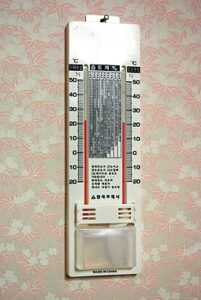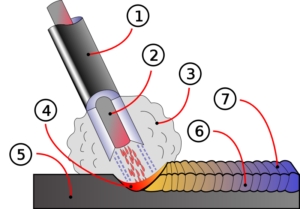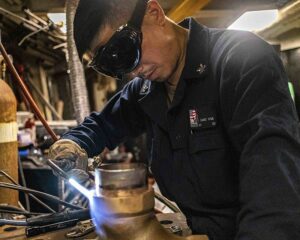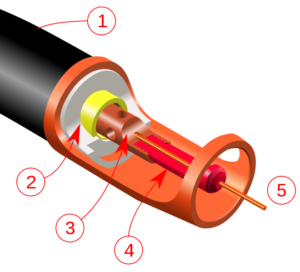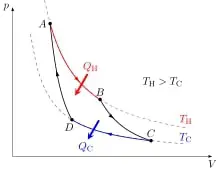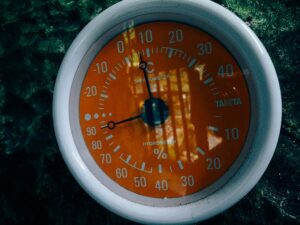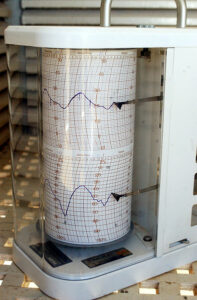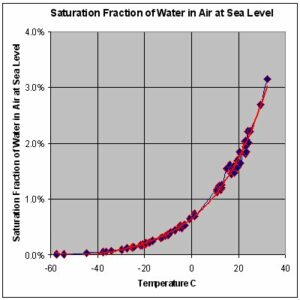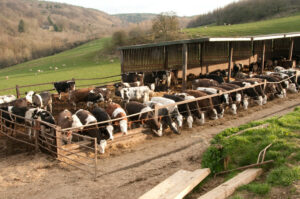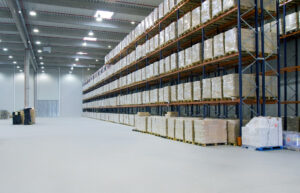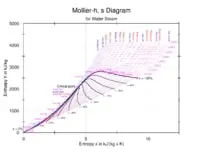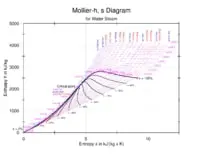Relative humidity is a measure of the amount of moisture present in the air compared to the maximum amount the air can hold at a particular temperature. It is an important parameter in weather forecasting, agriculture, and various industries. Calculating relative humidity involves comparing the actual vapor pressure of the air to the saturation vapor pressure at a given temperature. The formula to calculate relative humidity is: RH = (actual vapor pressure / saturation vapor pressure) x 100. To determine the actual vapor pressure, you need to know the temperature and the dew point. The saturation vapor pressure can be found using tables or equations based on temperature. Here are some key takeaways on how to calculate relative humidity:
| Key Takeaways |
|---|
| Relative humidity is the amount of moisture in the air compared to the maximum amount it can hold at a specific temperature. |
| The formula to calculate relative humidity is: RH = (actual vapor pressure / saturation vapor pressure) x 100. |
| Actual vapor pressure can be determined using the temperature and dew point. |
| Saturation vapor pressure can be found using tables or equations based on temperature. |
Understanding the Basics
Relative humidity is an important concept when it comes to understanding the moisture content in the air. It refers to the amount of water vapor present in the air compared to the maximum amount the air can hold at a specific temperature. In this section, we will explore the factors that affect relative humidity and the tools used to measure it.
Factors Affecting Relative Humidity
Several factors influence the relative humidity in the atmosphere. These factors include:
-
Temperature and Humidity: The relationship between temperature and humidity is crucial in determining relative humidity. As the temperature rises, the air can hold more moisture, resulting in a decrease in relative humidity. Conversely, as the temperature drops, the air’s capacity to hold moisture decreases, leading to an increase in relative humidity.
-
Atmospheric Pressure: Changes in atmospheric pressure can affect relative humidity. When the pressure decreases, the air expands, causing the temperature to drop. As a result, the relative humidity increases. Conversely, an increase in atmospheric pressure leads to a decrease in relative humidity.
-
Moisture Content: The amount of water vapor present in the air directly affects relative humidity. If more water vapor is added to the air, the relative humidity increases. Conversely, if water vapor is removed from the air, the relative humidity decreases.
-
Condensation and Evaporation: The processes of condensation and evaporation also impact relative humidity. When water vapor condenses into liquid water, it releases heat, causing the surrounding air to warm up. This increase in temperature leads to a decrease in relative humidity. On the other hand, when liquid water evaporates into water vapor, it absorbs heat from the surrounding air, resulting in a decrease in temperature and an increase in relative humidity.
Tools Used to Measure Relative Humidity
To measure relative humidity accurately, various tools and instruments are used. Some commonly used tools include:
-
Hygrometer: A hygrometer is a device specifically designed to measure relative humidity. It works by using a sensor that detects changes in moisture content in the air. Hygrometers can provide readings in both percentage and dew point temperature.
-
Psychrometric Chart: A psychrometric chart is a graphical representation of the relationship between temperature, humidity, and other properties of moist air. It helps in determining various parameters such as humidity ratio, dew point, and moisture content.
-
Humidity Sensors: Humidity sensors are electronic devices that measure relative humidity. They are often used in weather forecasting, indoor humidity control systems, and other applications where monitoring and controlling humidity levels are crucial.
How to Calculate Relative Humidity
Relative humidity is a measure of the amount of moisture present in the air compared to the maximum amount the air could hold at a specific temperature. It is an important factor in understanding and predicting weather patterns, as well as maintaining comfortable indoor environments. In this article, we will explore the basic formula for calculating relative humidity and provide an example to help you better understand the concept.
The Basic Formula for Calculating Relative Humidity
To calculate relative humidity, you need to know the current temperature and the dew point temperature. The dew point temperature is the temperature at which the air becomes saturated and condensation begins to form. The formula for calculating relative humidity is as follows:
Relative Humidity = (Actual Vapor Pressure / Saturation Vapor Pressure) * 100
Where:
– Actual Vapor Pressure is the pressure exerted by water vapor in the air.
– Saturation Vapor Pressure is the maximum pressure that water vapor can exert at a given temperature.
To calculate the actual vapor pressure, you can use the following formula:
Actual Vapor Pressure = Humidity Ratio / (Humidity Ratio + 1) * Atmospheric Pressure
Where:
– Humidity Ratio is the ratio of the mass of water vapor to the mass of dry air.
– Atmospheric Pressure is the pressure exerted by the air.
To calculate the saturation vapor pressure, you can refer to tables or use equations derived from the psychrometric chart. The saturation vapor pressure depends on the temperature and can be expressed in different units such as millibars, pascals, or inches of mercury.
Example of Calculating Relative Humidity
Let’s say the current temperature is 25 degrees Celsius and the dew point temperature is 20 degrees Celsius. We can use the formulas mentioned above to calculate the relative humidity.
First, we need to calculate the actual vapor pressure. Assuming the humidity ratio is 0.01 and the atmospheric pressure is 1013 millibars, we can substitute these values into the formula:
Actual Vapor Pressure = 0.01 / (0.01 + 1) * 1013 = 10.13 millibars
Next, we need to calculate the saturation vapor pressure at the given temperature. Using a table or an equation derived from the psychrometric chart, we find that the saturation vapor pressure at 25 degrees Celsius is approximately 23.8 millibars.
Now, we can substitute the values into the relative humidity formula:
Relative Humidity = (10.13 / 23.8) * 100 = 42.52%
Therefore, the relative humidity in this example is approximately 42.52%.
Calculating relative humidity is essential for various applications, including weather forecasting, indoor humidity control, and understanding the moisture content in the air. By knowing the relative humidity, you can determine if the air is too dry or too humid, which can affect comfort levels and even the health of individuals.
Remember, the formulas and calculations provided here are just one of the many humidity calculation methods available. Depending on the specific situation and available data, other formulas or conversion methods may be more appropriate. Additionally, modern devices such as hygrometers and humidity sensors can provide accurate measurements without the need for manual calculations.
So, the next time you wonder about the humidity level in your surroundings, grab a hygrometer, measure the temperature and dew point, and use the relative humidity formula to get the answer. Understanding relative humidity will help you better manage the air moisture level and ensure a comfortable and healthy environment.
Different Methods of Calculating Relative Humidity
Relative humidity is an important measurement when it comes to understanding the moisture content in the air. There are several methods available to calculate relative humidity, each with its own advantages and applications. In this article, we will explore five different methods of calculating relative humidity and discuss how they work.
Calculating Relative Humidity with Wet Bulb and Dry Bulb

One common method of calculating relative humidity is by using a wet bulb and dry bulb thermometer. This method relies on the principle of evaporation to determine the moisture content in the air. The wet bulb thermometer is wrapped in a wet cloth, which causes the water to evaporate and cool the thermometer. The dry bulb thermometer, on the other hand, is not affected by evaporation. By comparing the temperatures of the two thermometers, we can calculate the relative humidity using a psychrometric chart or a formula.
Calculating Relative Humidity with Temperature and Vapor Pressure
Another method of calculating relative humidity is by using temperature and vapor pressure. Vapor pressure is the pressure exerted by water vapor in the air and is directly related to the moisture content. By measuring the temperature and vapor pressure, we can determine the relative humidity using a formula or by referring to tables that provide the relationship between temperature, vapor pressure, and relative humidity.
Calculating Relative Humidity with Temperature and Dew Point
The dew point is the temperature at which the air becomes saturated and condensation begins to form. By measuring the temperature and dew point, we can calculate the relative humidity. The dew point is an important parameter in weather forecasting as it indicates the likelihood of fog, dew, or frost formation. There are formulas and charts available to determine the relative humidity based on the temperature and dew point values.
Calculating Relative Humidity from Absolute Humidity
Absolute humidity refers to the actual amount of water vapor present in the air. It is expressed in grams of water vapor per cubic meter of air. To calculate the relative humidity from absolute humidity, we need to know the saturation point of the air, which is the maximum amount of water vapor the air can hold at a given temperature. By comparing the absolute humidity to the saturation point, we can determine the relative humidity using a formula or a psychrometric chart.
Calculating Relative Humidity from Specific Humidity
Specific humidity is the ratio of the mass of water vapor to the total mass of air. It is expressed in grams of water vapor per kilogram of air. To calculate the relative humidity from specific humidity, we need to know the saturation point of the air and the total pressure. By comparing the specific humidity to the saturation point, we can determine the relative humidity using a formula or a psychrometric chart.
Using Tools to Calculate Relative Humidity
Using a Sling Psychrometer
When it comes to measuring humidity, one of the most commonly used tools is a sling psychrometer. This simple yet effective device allows you to determine the relative humidity by comparing the wet-bulb temperature and the dry-bulb temperature. The wet-bulb temperature is measured by wrapping a wet cloth around the bulb of the thermometer and then swinging it around in the air. As the water evaporates from the cloth, it cools down the bulb, giving you the wet-bulb temperature. On the other hand, the dry-bulb temperature is measured using a regular thermometer without any moisture on it.
To calculate the relative humidity using a sling psychrometer, you need to use the psychrometric chart. This chart provides a graphical representation of the relationship between temperature, humidity, and moisture content in the air. By finding the intersection point of the wet-bulb and dry-bulb temperatures on the chart, you can determine the humidity ratio, dew point, and relative humidity.
Using a Hygrometer
Another tool commonly used to measure humidity is a hygrometer. A hygrometer is an instrument that directly measures the moisture content in the air. There are different types of hygrometers available, including mechanical, electronic, and digital ones. Mechanical hygrometers typically use a hair or a synthetic material that expands or contracts with changes in humidity, while electronic and digital hygrometers use sensors to measure the water vapor in the air.
To use a hygrometer, you simply need to follow the manufacturer’s instructions. Most hygrometers provide a digital display of the relative humidity, making it easy to read and interpret. Some advanced models may also provide additional information such as the temperature and dew point. Hygrometers are widely used in various applications, including weather forecasting, indoor humidity monitoring, and controlling the air moisture level in certain environments.
Using Excel to Calculate Relative Humidity
If you prefer a more automated approach to calculate relative humidity, you can use Excel. Excel is a powerful tool that allows you to perform complex calculations, including humidity calculations. By utilizing the relative humidity formula and inputting the necessary data, you can quickly obtain the relative humidity value.
To calculate relative humidity using Excel, you need to gather the required data, including the dry-bulb temperature, wet-bulb temperature, and atmospheric pressure. Once you have the data, you can use the appropriate formula to calculate the relative humidity. Excel also allows you to create tables and graphs to visualize the data and track changes over time.
Using Excel to calculate relative humidity provides a convenient and efficient way to analyze large datasets and perform multiple calculations simultaneously. It is especially useful for researchers, scientists, and professionals who deal with extensive humidity data and require accurate and reliable results.
Practical Applications of Calculating Relative Humidity
Relative humidity is a crucial factor in various fields and industries. By accurately measuring and calculating relative humidity, we can gain valuable insights and make informed decisions. Let’s explore some practical applications of calculating relative humidity.
Calculating Humidity in a Room
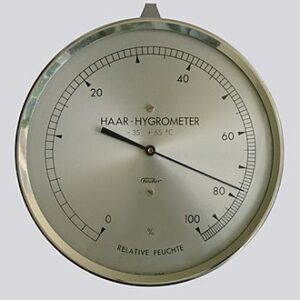
One of the most common applications of calculating relative humidity is in maintaining comfortable and healthy indoor environments. Understanding the humidity levels in a room is essential for ensuring the well-being of occupants and the preservation of certain materials.
To calculate the relative humidity in a room, we can use a combination of temperature and moisture content measurements. By employing a hygrometer, which is a device specifically designed to measure humidity, we can obtain accurate readings. The relative humidity formula takes into account the temperature, dew point, and the amount of water vapor present in the air.
By monitoring and controlling the humidity levels in a room, we can prevent issues such as condensation, mold growth, and discomfort caused by excessively dry or humid conditions. This is particularly important in environments such as homes, offices, museums, and storage facilities where maintaining optimal humidity levels is crucial.
Calculating Relative Humidity for Geographic Purposes
Calculating relative humidity is also essential for various geographic purposes, such as weather forecasting and climate studies. Understanding the moisture content in the atmosphere helps meteorologists predict and analyze weather patterns, including the formation of clouds, precipitation, and the likelihood of severe weather events.
Meteorologists utilize humidity calculation methods and psychrometric charts to determine the relative humidity based on temperature and atmospheric pressure measurements. These calculations aid in predicting the behavior of air masses, the formation of fog, and the potential for evaporation or condensation.
By accurately calculating relative humidity in different geographic regions, scientists can gain insights into climate patterns, assess the suitability of certain areas for agriculture, and study the impact of humidity on ecosystems and biodiversity.
Calculating Relative Humidity for Respiratory Therapy
Relative humidity plays a vital role in respiratory therapy, particularly in medical settings where patients require respiratory support. In these cases, it is crucial to maintain optimal humidity levels to ensure the comfort and well-being of patients.
Respiratory therapists use humidity sensors and specialized equipment to measure and control the humidity of inhaled air. By adjusting the humidity levels, they can prevent the drying of respiratory passages and minimize discomfort during treatments.
Calculating relative humidity in respiratory therapy involves considering factors such as the patient’s respiratory condition, the desired moisture level, and the temperature of the inhaled air. By providing the appropriate humidity, respiratory therapists can improve the effectiveness of treatments and enhance patient comfort.
Calculating relative humidity is an important aspect of understanding the moisture content in the air. By using the formula RH = (actual vapor pressure / saturation vapor pressure) * 100, we can determine the relative humidity percentage. This calculation involves measuring the actual vapor pressure and saturation vapor pressure, which can be obtained using various instruments and formulas. Understanding relative humidity is crucial in various fields such as meteorology, agriculture, and indoor comfort. By knowing the relative humidity, we can make informed decisions about ventilation, moisture control, and even predicting weather patterns. Overall, calculating relative humidity helps us understand and manage the moisture levels in our environment.
Frequently Asked Questions
1. How to calculate relative humidity from dew point and temperature?
Relative humidity can be calculated from dew point and temperature using the formula: RH = 100 * (EXP((17.625 * DP) / (243.04 + DP)) / EXP((17.625 * T) / (243.04 + T))), where RH is relative humidity, DP is dew point temperature, and T is actual temperature.
2. How to calculate relative humidity in Excel?
To calculate relative humidity in Excel, you can use the same formula as above. Input your dew point and temperature data in two separate columns, and then use Excel’s formula function to apply the formula to these columns.
3. What’s used to measure relative humidity?
Relative humidity is commonly measured using a device called a hygrometer. There are many types of hygrometers, including sling psychrometers, which use the difference between wet-bulb and dry-bulb temperatures to calculate relative humidity.
4. How to calculate relative humidity with a psychrometer?
A psychrometer measures relative humidity based on the difference in readings between two thermometers, one dry (dry-bulb) and one covered in a wet cloth (wet-bulb). The relative humidity can then be found using a psychrometric chart or formula.
5. How to calculate relative humidity without a chart?
If you don’t have a psychrometric chart, you can use a formula to calculate relative humidity. This typically involves the temperature, dew point, and sometimes the atmospheric pressure.
6. How to calculate relative humidity from absolute humidity?
Absolute humidity is the measure of water vapor (moisture) in the air, regardless of temperature. It’s possible to convert absolute humidity to relative humidity, but you’ll need to know the current temperature and dew point.
7. How to calculate relative humidity using a sling psychrometer?
A sling psychrometer is a type of hygrometer that has two thermometers: a dry bulb and a wet bulb. By spinning the psychrometer in the air, you can get the readings from both thermometers and calculate the relative humidity using a psychrometric chart or formula.
8. How to calculate relative humidity with temperature and vapor pressure?
Relative humidity can be calculated from temperature and vapor pressure using the formula: RH = (VP / SVP) * 100, where RH is relative humidity, VP is actual vapor pressure, and SVP is saturation vapor pressure at the same temperature.
9. How to calculate relative humidity from wet bulb temperature?

To calculate relative humidity from wet bulb temperature, you’ll need to know the dry bulb temperature as well. The difference between the two can be used in a psychrometric chart or formula to find the relative humidity.
10. How to calculate relative humidity from specific humidity?
Specific humidity is the ratio of water vapor mass to the total mass of moist air parcel. To calculate relative humidity from specific humidity, you’ll need to know the temperature and pressure, and use these in a specific formula or psychrometric chart.
